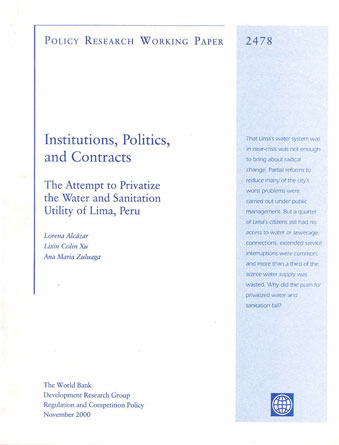Institutions, politics and contracts: the privatization attempt of the water and sanitation utility of Lima, Peru
| Año | : | 2000 |
|---|---|---|
| Autor/es | : | Lorena Alcázar, Lixin Colin Xu, Ana María Zuluaga |
| Área/s | : | Reforma del Estado e instituciones públicas |
[2000] ALCAZAR, Lorena; XU, Lixin Colin; ZULUAGA, Ana María. Institutions, politics, and contracts: the privatization attempt of the water and sanitation utility of Lima, Peru.. Washington, D.C.: World Bank. 56 p. Policy research working paper, 2478.
In 1989-90 Peru underwent a severe economic crisis with a 5.4 percent decline in GDP and inflation peaking at an annual rate of over 7,600 percent (World Bank 1998). The newly elected President, Alberto Fujimori, embarked on a program of sweeping structural reforms that turned Peru from a state-directed to a market-led economy.
The reforms changed the role of the state through the sale of more than 200 state owned enterprises, sharply reduced state subsidies and price controls, and introduced tax, wage and other measures designed to improve the efficiency and financial soundness of government. Included in the program was a proposal to privatize the operation of Lima’s water and sewerage utility, by means of a concession contract.
As we shall show, Lima’s water and sewerage system was in a state of near collapse by the time of Fujimori’s election in 1990. Water is scarce in the arid coastal region where Lima is located, and leakage, waste, and contamination of water sources compounded this natural scarcity. The result was severe rationing and frequent interruptions for the 75 percent of the population connected to the system, and high costs and inconvenience for the 25 percent without direct access to piped water. In addition, almost a third of Lima’s 1991 population of 6.5 million were not connected to the sewerage system. Sewerage treatment was almost non-existent and Lima dumped raw sewerage into the ocean at a rate of 17 to 18 M3 per second. Low tariffs for water services, lack of metering and low rates of bill collection had left SEDAPAL with neither the incentive nor the resources to expand or maintain the system, and gave consumers little incentive to curb water consumption except during rationing.
The social and external costs of the system were large: high rates of illness and death from water borne diseases, pollution of rivers used for irrigation and of the ocean used for fishing, depletion of the groundwater, and losses of exports and tourism during the 1991 cholera epidemic. Conditions thus seemed ripe for Lima’s water and sewerage concession. The water and sewerage system was in crisis and the political circumstances favored privatization. Yet the concession did not happen. Even though a number of reforms short of privatization were implemented, we shall show that the welfare gains to Peru from these were well below the potential gains had the concession gone ahead as planned.
The objective of this study is to analyze the reforms that SEDAPAL underwent instead of the concession, to explore the consequences of that change for water services in Lima, and to explain why the concession was not signed. The next section of this study discusses the circumstances in the water sector leading to reform. Section III discusses the reforms that were implemented. Section IV compares the welfare effects of reform with the concession. Section V explores the political circumstances that explain why the operation of the water system was not privatized. We conclude with a discussion of the remaining problems and the implications of the Lima case for policy.






